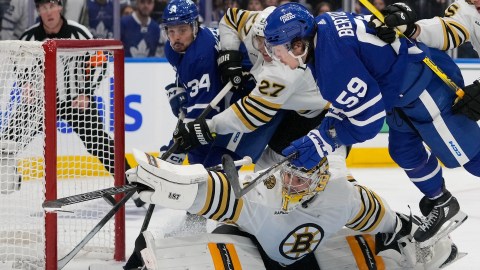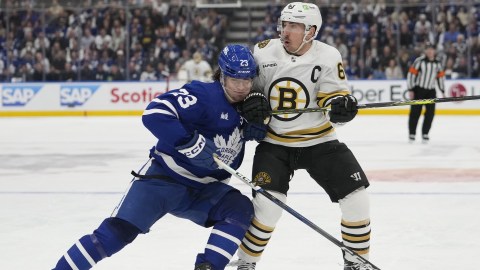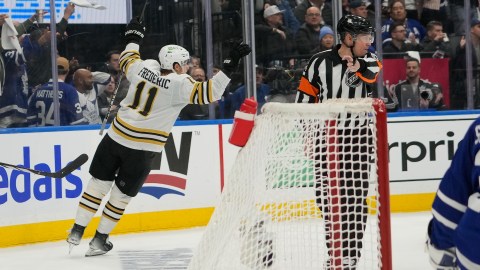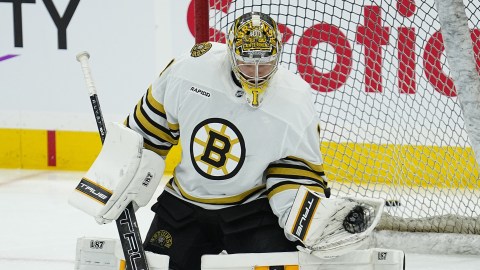WILMINGTON, Mass. — The Boston Bruins had the third-best power play last season and it played a key role in them winning the Presidents’ Trophy.
Scoring with the man advantage has been difficult for Boston this campaign, though. The offseason departures of 30-goal winger Jarome Iginla and assistant coach Geoff Ward have affected the unit to some degree, but the losses of top-six center David Krejci and No. 1 defenseman Zdeno Chara for 20 and 19 games, respectively, because of injuries also played a role in the power play’s struggles.
When the Bruins got Krejci back in the lineup on Dec. 17, the power play started to establish some consistency.
The B’s have scored one power-play goal in seven of the last 10 games, most recently in Saturday’s 3-1 win over the Philadelphia Flyers when rookie forward David Pastrnak scored his first career NHL goal.
In the 12 games since Krejci returned to the power play, Boston has averaged 7.42 shot attempts and four scoring chances per game with the man advantage, according to War on Ice.
How well have the Bruins created scoring chances during power-play opportunities when Krejci was in-and-out of the lineup over the first 29 games compared to his last 12 games? Here’s a look using scoring chances for percentage, scoring chances per 60 minutes and on-ice shooting percentage (all via War on Ice, NHL rank in parenthesis).
| Power Play | SCF% | SCF/60 | OSh% |
| First 31 Games | 89.4 (9th) | 53.4 (10th) | 10.2 (21st) |
| Last 12 Games | 92.3 (7th) | 60.2 (4th) | 16.3 (7th) |
As the chart above shows, the Bruins have improved a bit in each category since Krejci returned in mid-December.
The shooting percentage increase was expected because the Bruins were in the bottom third of the league in SH% during 5-on-5 and power-play situations throughout the first three months of the campaign. It was only a matter of time before the B’s had a little more luck, and it also helps to have a playmaker of Krejci’s caliber on the power play full-time.
He slows the game down, exhibits tremendous patience with the puck and is able to find teammates in scoring areas. Seth Griffith’s power-play goal on Dec. 29 against the Detroit Red Wings is a fine example.
Chara’ return to the lineup is giving the Bruins another dimension on the power play, too. At 6-foot-9 and 255 pounds, he’s almost impossible to move from the front of the net and his size makes it difficult for opposing goaltenders to locate the puck on shots from the perimeter. A screen by Chara helped Milan Lucic score a power-play goal in Thursday’s win over the New Jersey Devils
The addition of Pastrnak also has made a positive impact on the power play. The 18-year-old winger isn’t afraid to go to the net, which we saw on his first goal Saturday, and his speed and puck-handling skill helps the Bruins enter the attacking zone cleanly instead of just dumping the puck in. Pastrnak’s power-play skill likely will be among the factors that go into the decision on whether to keep him at the NHL level full-time this season or send him back to the AHL.
The Bruins currently rank 14th with an 18.8 percent success rate on the power play. Despite the recent increase in goals scored on the power play, there still is plenty of room for improvement, as evidenced by the final three power-play opportunities Saturday that failed to produce many good looks at the net.
Boston needs its power play to be a strength even more than in recent seasons because its 5-on-5 scoring is down from 2013-14. There isn’t as much scoring depth with this roster, so special teams will be even more important in the Bruins’ fight for a playoff spot.
Thumbnail photo via Tom Szczerbowski/USA TODAY Sports Images



